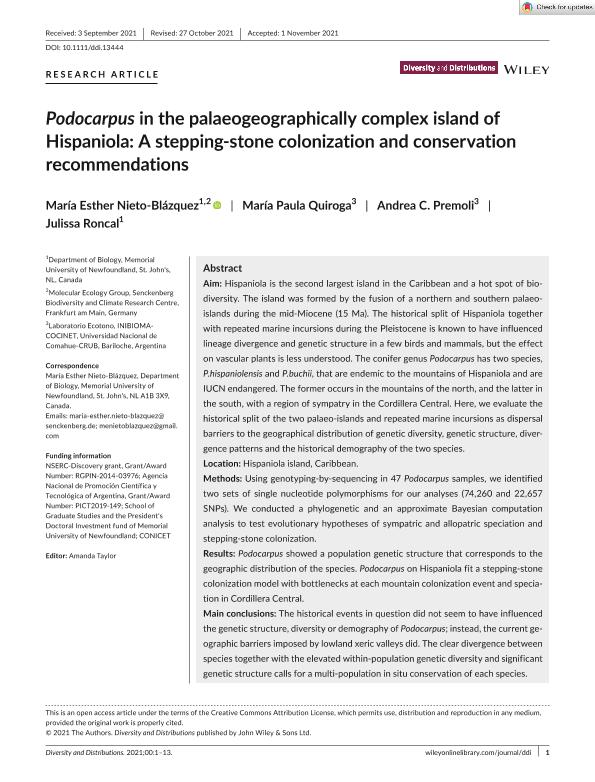Mostrar el registro sencillo del ítem
dc.contributor.author
Nieto Blázquez, María Esther
dc.contributor.author
Quiroga, María Paula

dc.contributor.author
Premoli Il'grande, Andrea Cecilia

dc.contributor.author
Roncal, Julissa
dc.date.available
2023-01-09T14:16:06Z
dc.date.issued
2021-12
dc.identifier.citation
Nieto Blázquez, María Esther; Quiroga, María Paula; Premoli Il'grande, Andrea Cecilia; Roncal, Julissa; Podocarpus in the palaeogeographically complex island of Hispaniola: A stepping-stone colonization and conservation recommendations; Wiley Blackwell Publishing, Inc; Diversity and Distributions; 28; 2; 12-2021; 214-226
dc.identifier.issn
1366-9516
dc.identifier.uri
http://hdl.handle.net/11336/183911
dc.description.abstract
Aim: Hispaniola is the second largest island in the Caribbean and a hot spot of biodiversity. The island was formed by the fusion of a northern and southern palaeo-islands during the mid-Miocene (15 Ma). The historical split of Hispaniola together with repeated marine incursions during the Pleistocene is known to have influenced lineage divergence and genetic structure in a few birds and mammals, but the effect on vascular plants is less understood. The conifer genus Podocarpus has two species, P.hispaniolensis and P.buchii, that are endemic to the mountains of Hispaniola and are IUCN endangered. The former occurs in the mountains of the north, and the latter in the south, with a region of sympatry in the Cordillera Central. Here, we evaluate the historical split of the two palaeo-islands and repeated marine incursions as dispersal barriers to the geographical distribution of genetic diversity, genetic structure, divergence patterns and the historical demography of the two species. Location: Hispaniola island, Caribbean. Methods: Using genotyping-by-sequencing in 47 Podocarpus samples, we identified two sets of single nucleotide polymorphisms for our analyses (74,260 and 22,657 SNPs). We conducted a phylogenetic and an approximate Bayesian computation analysis to test evolutionary hypotheses of sympatric and allopatric speciation and stepping-stone colonization. Results: Podocarpus showed a population genetic structure that corresponds to the geographic distribution of the species. Podocarpus on Hispaniola fit a stepping-stone colonization model with bottlenecks at each mountain colonization event and speciation in Cordillera Central. Main conclusions: The historical events in question did not seem to have influenced the genetic structure, diversity or demography of Podocarpus; instead, the current geographic barriers imposed by lowland xeric valleys did. The clear divergence between species together with the elevated within-population genetic diversity and significant genetic structure calls for a multi-population in situ conservation of each species.
dc.format
application/pdf
dc.language.iso
eng
dc.publisher
Wiley Blackwell Publishing, Inc

dc.rights
info:eu-repo/semantics/openAccess
dc.rights.uri
https://creativecommons.org/licenses/by/2.5/ar/
dc.subject
DISPERSAL BARRIERS
dc.subject
HISPANIOLA
dc.subject
HISTORICAL DEMOGRAPHY
dc.subject
IN SITU CONSERVATION
dc.subject.classification
Conservación de la Biodiversidad

dc.subject.classification
Ciencias Biológicas

dc.subject.classification
CIENCIAS NATURALES Y EXACTAS

dc.title
Podocarpus in the palaeogeographically complex island of Hispaniola: A stepping-stone colonization and conservation recommendations
dc.type
info:eu-repo/semantics/article
dc.type
info:ar-repo/semantics/artículo
dc.type
info:eu-repo/semantics/publishedVersion
dc.date.updated
2022-10-06T13:11:41Z
dc.journal.volume
28
dc.journal.number
2
dc.journal.pagination
214-226
dc.journal.pais
Reino Unido

dc.journal.ciudad
Londres
dc.description.fil
Fil: Nieto Blázquez, María Esther. Memorial University Of Newfoundland. Faculty Of Science; Canadá. Senckenberg Biodiversity and Climate Research Centre; Alemania
dc.description.fil
Fil: Quiroga, María Paula. Consejo Nacional de Investigaciones Científicas y Técnicas. Centro Científico Tecnológico Conicet - Patagonia Norte. Instituto de Investigaciones en Biodiversidad y Medioambiente. Universidad Nacional del Comahue. Centro Regional Universidad Bariloche. Instituto de Investigaciones en Biodiversidad y Medioambiente; Argentina
dc.description.fil
Fil: Premoli Il'grande, Andrea Cecilia. Consejo Nacional de Investigaciones Científicas y Técnicas. Centro Científico Tecnológico Conicet - Patagonia Norte. Instituto de Investigaciones en Biodiversidad y Medioambiente. Universidad Nacional del Comahue. Centro Regional Universidad Bariloche. Instituto de Investigaciones en Biodiversidad y Medioambiente; Argentina
dc.description.fil
Fil: Roncal, Julissa. Memorial University Of Newfoundland. Faculty Of Science; Canadá
dc.journal.title
Diversity and Distributions

dc.relation.alternativeid
info:eu-repo/semantics/altIdentifier/url/https://onlinelibrary.wiley.com/doi/10.1111/ddi.13444
dc.relation.alternativeid
info:eu-repo/semantics/altIdentifier/doi/http://dx.doi.org/10.1111/ddi.13444
Archivos asociados
